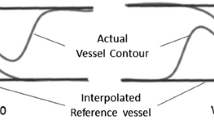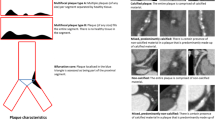Abstract
Because of limited storage capacity for digital images, angiographic laboratories without cinefilm are dependent on locally performed quantitative coronary angiography (QCA) in clinical studies. In the present study the intra-and interobserver variability, as well as variability between different laboratories and variability due to frame selection was analyzed. A total of 20 coronary lesions were studied in two different digital laboratories 12±8 days apart. Images were analyzed on-line and after being transferred to a Cardiac Work Station (CWS). There was no significant difference between the measurement situations. For minimal luminal diameter (MLD) precision (SD of signed errors) ranged from 0.12 mm to 0.20 mm, for reference diameter (RD) from 0.15 mm to 0.28 mm, and for percent diameter stenosis (DS) from 4.2% to 5.8%. Overall relative precision was obtained by normalizing the QCA parameters, and was 11.9% for MLD, 7.0% for RD and 8.5% for DS (p<0.001, RD and DS compared to MLD). The overall variability in the interobserver and in the interlaboratory comparisons was 11.2% and 10.4%, respectively (n.s.) (n.s.). Thus the variability of QCA performed in cinefilmless, digital laboratories is small, and within a range making it an useful tool for clinical practice and group comparisons in clinical studies. However, the error range of QCA measurements must be taken into consideration when judging results from individual patients.
Similar content being viewed by others
References
Reiber JHC, Serruys PW, Kooijman CJ, Wijns W, Slager CJ, Gerbrands JJ et al. Assessment of short-, medium- and long-term variations in arterial dimensions from computer-assisted quantitation of coronary cineangiograms. Circulation 1985; 71: 280–8.
Hermiller JB, Cusma JT, Spero LA, Fortin DF, Harding MB, Bashore TM. Quantitative and qualitative coronary angiographic analysis: review of methods, utility, and limitations. Cathet Cardiovasc Diagn 1992; 25: 110–31.
Strauss BH, Escaned J, Foley DP, Di Mario C, Haase J, Keane D et al. Technologic considerations and practical limitations in the use of quantitative angiography during percutaneous coronary recanalization. Prog Cardiovasc Dis 1994; 36: 343–62.
Reiber JHC, van der Zwet PMJ, von Land CD, Koning G, Loois G, Zorm I et al. On-line quantification of coronary arteriograms with the DCI system. Medicamundi 1989; 34: 89–98.
Gronenschild E, Janssen J, Tijdens F. CAASII: A second generation system for off-line and on-line quantitative coronary angiography. Cathet Cardiovasc Diagn 1994; 33: 61–75.
Reiber JHC, van der Zwet PMJ, Koning G, von Land CD, van Meurs B, Gerbrands JJ et al. Accuracy and precision of quantitative digital coronary arteriography: observer-, short-, and medium-term variabilities. Cathet Cardiovasc Diagn 1993; 28: 187–98.
Haase J, Di Mario C, Slager CJ, van der Giessen WJ, den Boer A, de Feyter PJ et al. In-vivo validation of on-line and off-line geometric coronary measurements using insertion of stenosis phantoms in porcine coronary arteries. Cathet Cardiovasc Diagn 1992; 27: 16–27.
Austen WG, Edward JE, Frye RL, Gensini GG, Gott VL, Griffith LSC et al. A reporting system on patients evaluated for coronary artery disease. Report of the ad hoc committee for grading of coronary artery disease Council On Cardiovascular Surgery, American Heart Association Assocoation. Circulation 1975; 51: 7–40.
Bland JM, Altman DG. Statistical methods for assessing agreement between two methods of clinical measurement. Lancet 1986; 1: 307–10.
Snedecor GW, Cochran WG. Comparison of two correlated variances in paired samples. Statistical methods. Ames, Iowa: The Iowa State University Press, 1980: 190–191.
Altman DG. Two way analysis of variance. Practical statistics for medical research. London: Chapman & Hall, 1991: 326–333.
Herrington DM, Siebes M, Sokol DK, Siu CO, Walford GD. Variability in measures of coronary lumen dimensions using quantitative coronary angiography. J Am Coll Cardiol 1993; 22: 1068–74.
Keane D, Haase J, Slager CJ, van Swijndregt EM, Lehmann KG, Ozaki Y et al. Comparative Validation of Quantitative Coronary Angiography Systems. Results and implications from a multicenter study using a standardized approach. Circulation 1995; 91: 2174–83.
Sanz ML, Mancini GBJ, LeFree MT, Mickelson JK, Starling MR, Vogel RA et al. Variability of quantitative digital sub-traction coronary angiography before and after percutaneous transluminal coronary angioplasty. Am J Cardiol 1987; 60: 55–60.
Stevenson RN, Roberts RH, Brecker SJ, Timmins J, Wilkinson PD, Balcon R. Comparison of digital angiograms with conventional cineangiograms for the quantitation of coronary artery stenosis before and after angioplasty. Coronary artery disease 1992; 3: 1183–8.
Foley DP, Escaned J, Strauss BH, Di Mario C, Haase J, Keane D et al. Quantitative coronary angiography (QCA) in interventional cardiology: clinical application of QCA measurements. Prog Cardiovasc Dis 1994; 36: 363–84.
Ellis SG, Pinto IM, McGillem MJ, De Boe SF, Le Free MT, Mancini GB. Accuracy and reproducibility of quantitative coronary arteriography using 6 and 8 French catheters with cine angiographic. Cathet Cardiovasc Diagn 1991; 22: 52–5.
Lespérance J, Bourassa MG, Schwartz L, Hudon G, Laurier J, Eastwood C et al. Definition and measurement of restenosis after successful coronary angioplasty: implications for clinical trials. Am Heart J 1993; 125: 1394–408.
Fortin DF, Spero LA, Cusma JT, Santori L, Burgess R, Bashore TM. Pitfalls in determination of absolute dimensions using angiographic catheters as calibration devices in quantitative angiography. Am J Cardiol 1991; 68: 1176–82.
Mancini GBJ, Williamson PR, DeBoe SF. Effect of coronary stenosis severity on variability of quantitative arteriography, and implications for interventional trials. Am J Cardiol 1992; 69: 806–807.
Gurley JC, Nissen SE, Booth DC, De Maria AN. Influence of operator- and patient-dependent variables on the suitability of automated quantitative coronary arteriography. J Am Coll Cardiol 1992; 19: 1237–43.
Author information
Authors and Affiliations
Rights and permissions
About this article
Cite this article
Sirnes, P.A., Myreng, Y., Mølstad, P. et al. Reproducibility of quantitative coronary analysis. Int J Cardiac Imag 12, 197–203 (1996). https://doi.org/10.1007/BF01806223
Accepted:
Issue Date:
DOI: https://doi.org/10.1007/BF01806223




